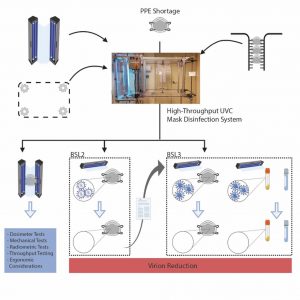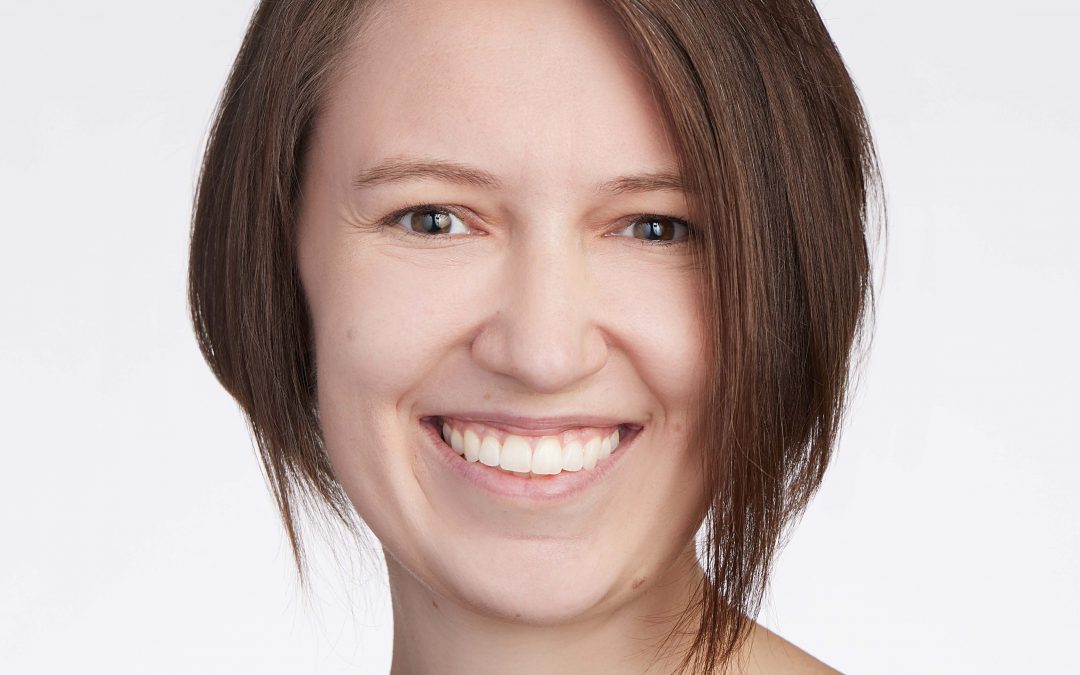Early in the COVID-19 pandemic, interdisciplinary teams at Mount Sinai and Rensselaer Polytechnic Institute (RPI) collaborated on two COVID critical needs projects with funding from the CTSA.
The teams of scientists at Mount Sinai and RPI with complementary expertise joined forces to address these critical needs. This included teams of experts in Bioengineering, Environment Health, Infectious Diseases, Virology, Pulmonary and Sleep Medicine, Lighting and UVC disinfection, Civil Engineering, Mechanical Engineering, Electrical Engineering and Biodesign. All experts contributed their time on a voluntary basis in order to help create new solutions to help with the crisis.
We recently interviewed Priti Balchandani, the Associate Director of The Biomedical Engineering and Imaging Institute (BMEII), who took the lead on assembling the teams with Deepak Vashisth at RPI, to discuss these projects.
UVC Germicidal system for PPE
 UVC radiation (200nm-280nm) has germicidal capabilities for airborne and surface viruses but its suitability for volumetric disinfection of contaminated respirator material is not well established. We aimed to establish UVC dose levels required for incapacitating the COVID-19 virus so UVC-disinfection systems may be deployed. A UVC germicidal device was designed and built at RPI by Bob Karlicek’s team to facilitate the safe reuse of N95 respirators. With help from international health and airborne disease expert specializing in lighting and UVC application, Richard Vincent, a rapid UVC germicidal disinfection protocol was devised that can be scaled up and is able to effectively inactivate SARS-CoV2 in potentially contaminated respirators. Anthony Costa, Director of Biodesign, was working in parallel to help with the COVID-19 crisis on several fronts and took on leadership on the Sinai side for PPE-related projects, including advising on integration of this UVC germicidal system into future hospital operational workflow. Mattheos Koffas and Brigitte Arduini at RPI evaluated experimental parameters that can optimize decontamination efficacy, such as decontamination UVC dose requirements, using surrogate viruses in a Biosafety Level 2 (BSL-2) facility at RPI. After development and testing in BSL2 at RPI, the germicidal system was shipped to Mount Sinai. Adolfo Garcia-Sastre’s team tested efficacy of one of the UVC fixtures from the system against the SARS-CoV-2 virus in the BSL3 facility at Mount Sinai. We concluded that UVC germicidal irradiation of N95 snippets inoculated with SARS-CoV2 for 120s per side resulted in 100% reduction of virus. These data support the reuse of N95 particle-filtrate apparatus upon irradiation with UVC as a measure to address the shortage of N95 essential workers during the COVID19 pandemic. The current work is broadly applicable for healthcare-settings, particularly during a pandemic such as COVID19. An emergency use authorization (EUA) submission for the FDA and manuscript is currently in preparation to report our findings and enable deployment of the device.
UVC radiation (200nm-280nm) has germicidal capabilities for airborne and surface viruses but its suitability for volumetric disinfection of contaminated respirator material is not well established. We aimed to establish UVC dose levels required for incapacitating the COVID-19 virus so UVC-disinfection systems may be deployed. A UVC germicidal device was designed and built at RPI by Bob Karlicek’s team to facilitate the safe reuse of N95 respirators. With help from international health and airborne disease expert specializing in lighting and UVC application, Richard Vincent, a rapid UVC germicidal disinfection protocol was devised that can be scaled up and is able to effectively inactivate SARS-CoV2 in potentially contaminated respirators. Anthony Costa, Director of Biodesign, was working in parallel to help with the COVID-19 crisis on several fronts and took on leadership on the Sinai side for PPE-related projects, including advising on integration of this UVC germicidal system into future hospital operational workflow. Mattheos Koffas and Brigitte Arduini at RPI evaluated experimental parameters that can optimize decontamination efficacy, such as decontamination UVC dose requirements, using surrogate viruses in a Biosafety Level 2 (BSL-2) facility at RPI. After development and testing in BSL2 at RPI, the germicidal system was shipped to Mount Sinai. Adolfo Garcia-Sastre’s team tested efficacy of one of the UVC fixtures from the system against the SARS-CoV-2 virus in the BSL3 facility at Mount Sinai. We concluded that UVC germicidal irradiation of N95 snippets inoculated with SARS-CoV2 for 120s per side resulted in 100% reduction of virus. These data support the reuse of N95 particle-filtrate apparatus upon irradiation with UVC as a measure to address the shortage of N95 essential workers during the COVID19 pandemic. The current work is broadly applicable for healthcare-settings, particularly during a pandemic such as COVID19. An emergency use authorization (EUA) submission for the FDA and manuscript is currently in preparation to report our findings and enable deployment of the device.
A longer-term goal is the testing of upper room UVC fixtures and possibly newer far UVC for sterilization of room air and surfaces that are potentially safe for human skin and eye exposure. This will require more research on dose that is safe for humans as well as environmental safety.
Joint project on UV to disinfect exhaled air from non-invasive ventilators (CPAPs)
Non-invasive ventilation (NIV) in COVID-19 patients with mild or moderate respiratory distress may be an effective strategy in the face of a viral pandemic. NIV delivers positive pressure ventilation through a non-invasive nasal or face mask. The use of NIVs, appropriately modified to reduce aerosolization of the virus, could provide alternatives for patients who need help with breathing during upcoming surge in a ventilator shortage.
In collaboration with RPI, a device is being developed that that uses UV lamps to disinfect exhaled air from a continuous positive airway pressure (CPAP) machine that has been pulled into a tube/chamber. This prevents air with COVID-19 virus from entering the room and helps solve the problem of aerosolized virus infecting caregivers. An early prototype proposed by inventor James Paredes has been iterated upon by experts at both Mount Sinai and RPI including Richard Vincent, Bob Karlicek and Matt Oehlschlaeger. Under the guidance of David Rapoport, Professor of Pulmonary Medicine at Mount Sinai, the team came up with a final design for the CPAP exhalate disinfection device and are purchasing the components to build a prototype at Sinai. Designer Jacob Wolf, advised by Anthony Costa, will be building the prototype at Sinai in the Biodesign facility. With the help of Helen Zha at RPI, we have devised a specialized setup to generate aerosolized virus and Adolfo Garcia-Sastre and his team have designed an overall experimental system in the BSL3 facility at Mount Sinai to show efficacy in eliminating the virus from the exhalate. The objective is to build and test a final design for a low-cost, easily deployable device to use in conjunction with any CPAP machine. We will form a whitepaper on this prototype and it will be the basis of a future grant application for the NIH.
UVC PPE sterilization team:
Mount Sinai: Richard Vincent, Adolfo Garcia-Sastre, Michael Schotsaert, Raveen Rathnasinghe, Priti Balchandani, Anthony Costa.
RPI: Bob Karlicek, Deepak Vashishth, Mattheos Koffas, Brigitte Arduini, Mohammed Alnaggar.
UVC CPAP device team:
Individual Inventor: James Paredes.
Mount Sinai: David Rapoport, Richard Vincent, Adolfo Garcia-Sastre, Michael Schotsaert, Anthony Costa, Jacob Wolf, Priti Balchandani, Drew Copeland, Neomi Shah, Philip Williams.
RPI: Bob Karlicek, Matt Oehlschlaeger, Helen Zha.
ConduITS is supported by NCATS of the NIH’s CTSA Program. Any use of CTSA-supported resources requires citation of grant number UL1TR001433 awarded to ISMMS in the acknowledgment section of every publication resulting from this support. Adherence to the NIH Public Access Policy is also required.


